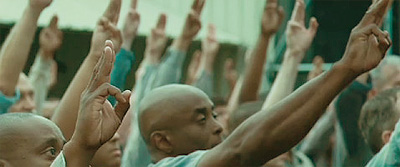This week I decided to try to incorporate the wildly popular game Among Us as a review lesson in my classroom.
My school has been in-person for about two months. There are many restrictions in place to keep everyone a safe as possible - desks six feet apart, masks, limited movement in the classroom among many other protocols. Many of my engagement activities have been heavily modified or eliminated due to the restrictions, so I have been trying to figure out new ways to increase engagement and excitement.
Enter Among Us. If you are not familiar, Among Us is a wildly popular game/app apparently played by nearly every middle schooler in the country. You play the role of a member of a derelict spacecraft and are either one of the 'crew mates' or an 'imposter.' While the goal of the crew is to save the ship, the goal of the imposter is to prevent repairs and eliminate all of the crew members. If you have played camp games such as Mafia or Town of Salem, it is very similar.
How, though, to do this within the classroom of restrictions? The game itself has a few basic characteristics: Crew members complete tasks in any order to save the ship. Imposters sabotage repairs and try to kill off crew members. There is a vote to eject a player. The goal of the crew is to eject the imposter. The goal of the imposter is to have them eject crew members.
I decided to use Desmos to build the game. My thought was the first slide could be instructions, then some slides for 'tasks', a slide for the imposter to eliminate a crew member, a slide for a chat, and a slide for the group vote. Then have two slides at the end: one for a crew mate victory, and one for an imposter victory.
On Friday, I tried it out. To say it was well received would be an understatement. I first asked how many students had played before and every.single.hand.went.up. The excitement and anticipation was incredible. They were already lobbing "how are we" and "what if" questions my way when I asked them to filter their questions and reminded them I haven't explained the rules or procedures.
I emailed one student a message that said, "you are the imposter" and had each of them check their laptop (we are a 1:1 Apple school.) They then logged into the Desmos as a class. I explained that there are eight tasks (review slides) that they can complete in any order. Meanwhile the imposter needs to also do some tasks because if they just stay on one screen it will look very sus. Their job would be to get to screen nine, pick two classmates to eliminate, and return to tasks without being noticed.
The game started and after a few minutes of them doing tasks the imposter struck and I hit the pause button. A small gasp was heard as students realized what was happening. On the board I wrote two names - students that are now ghosts. I opened up the chat and voting screens and let them discuss via chat, though they were more than excited to share their opinions verbally. For this classroom version, I let everyone vote. After some discussion, the vote leaned towards 'skip' and nobody was ejected.
Round two came to an end with an ejection and an announcement from me: "E____ was ejected.... E____ was NOT the imposter. One imposter remains..." Having the eject sound effect play added to the experience.
Rounds three, four, and five all led to ejections as well.. and all none were the imposter. Unfortunately at that point we were out of time so the imposter revealed herself and an audible group of "I KNEW IT" and "YOU WERE SO SUS!" erupted.
The students were so enthralled by the game that their next-period teachers told me they had to remind students that the game was over and they needed to focus on their current assignment.
So from a student perspective it was a smash hit - but what about from the math review side? All of it is fun, but if they didn't do their review tasks it wouldn't really be effective. I was so happy to see it was very successful. Students completed tasks with expected levels of accuracy and relatively quickly. Many had nearly all 8 tasks complete by the time the game ended.
I can't wait to try this one again. I'm looking for ways to as a 'sabotage' element to the game, so any of my readers that have experience with Desmos and could suggest something, I'd love to hear from you.














